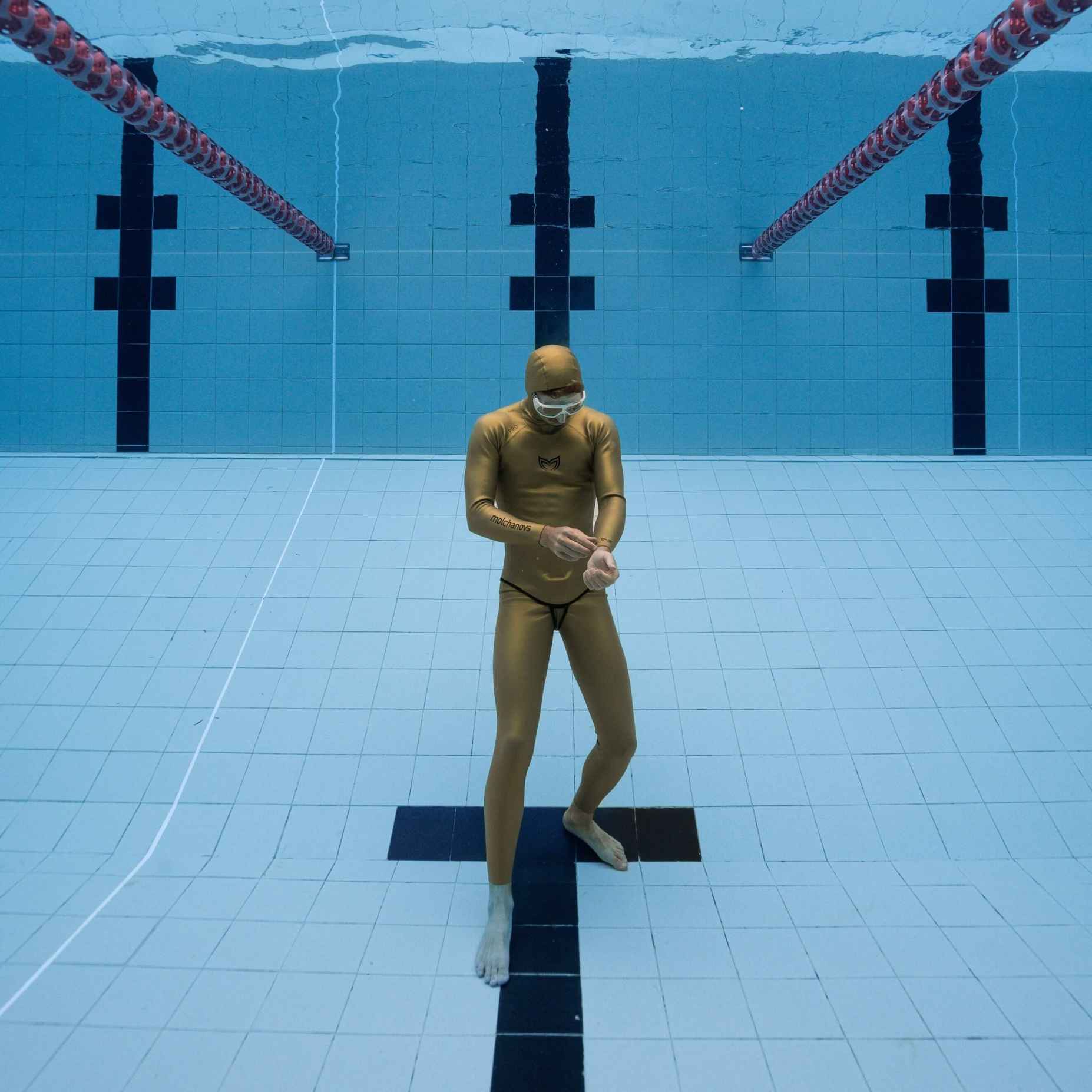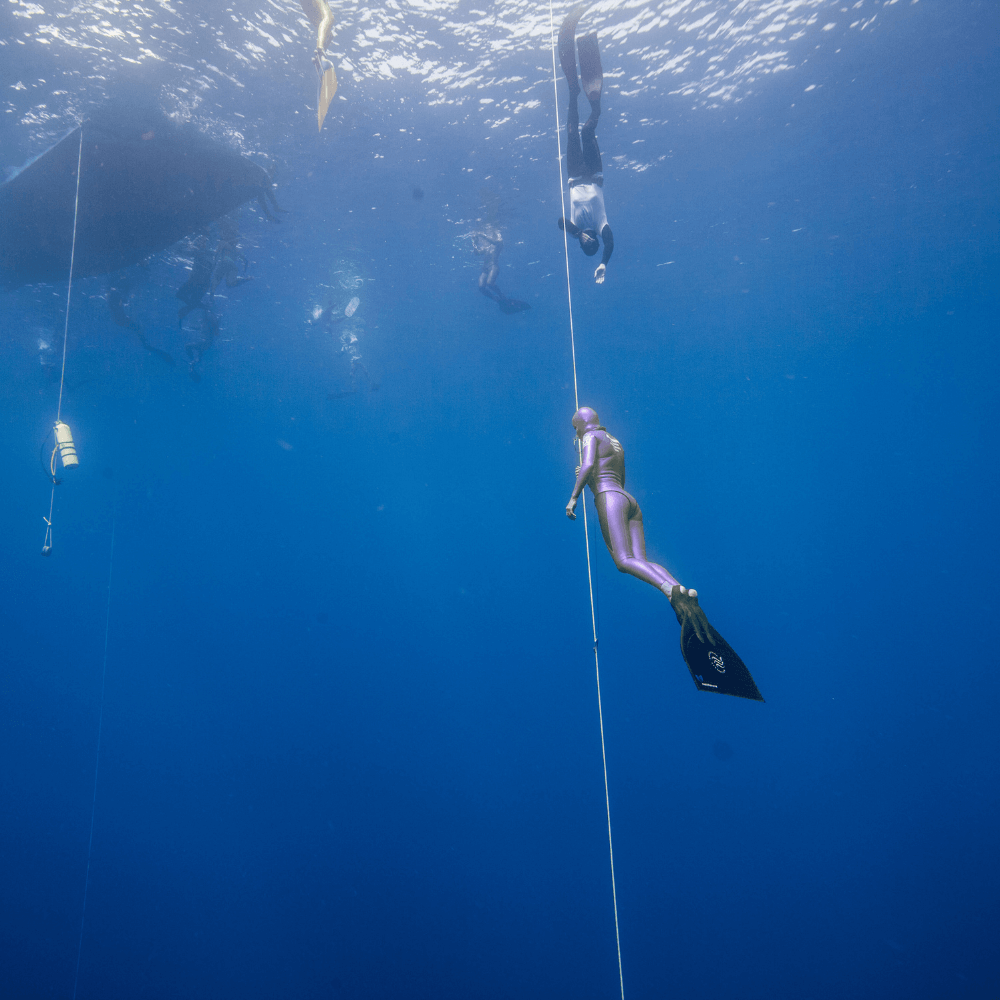플라스틱과 유리 프리다이빙 마스크에 대한 빠른 가이드

플라스틱과 유리 중 어떤 프리다이빙 마스크를 구매해야 합니까?
작성자: 크리스티나 즈바리치
기여자: 아시야 클레쉬체프니코바, 디나 린치
사진 © @andac.카자르.
논쟁은 현실입니다. 프리다이빙을 위해 플라스틱 마스크를 써야 할까요, 아니면 유리 마스크를 써야 할까요? 불행히도 대답은 그렇게 간단하지 않습니다. 누구나 선호하는 마스크가 있고 각 마스크마다 장단점이 있습니다. 중요한 것은 다이빙 스타일과 필요에 가장 적합한 선택을 할 수 있도록 각 재료가 무엇을 제공하는지 이해하는 것입니다. 이 두 가지의 차이점과 각 유형을 관리하는 방법을 알아보려면 계속해서 읽어보세요!
플라스틱(폴리카보네이트) 프리다이빙 마스크
 는 CORE 프리다이빙 마스크 넓은 시야를 제공하므로 프리다이버가 주변을 쉽게 볼 수 있습니다. 사진 © 안닥.카자르
는 CORE 프리다이빙 마스크 넓은 시야를 제공하므로 프리다이버가 주변을 쉽게 볼 수 있습니다. 사진 © 안닥.카자르
장점
넓은 시야
4개의 렌즈(양쪽에 2개씩)가 있는 스쿠버 다이빙 마스크가 주변 시야를 제공하지만 자연적으로 용량이 더 커집니다. 즉, 하강할 때 마스크를 더 자주 균등화해야 하며 프리다이빙에 적합하지 않습니다. 그러나 플라스틱 렌즈는 구부러질 수 있어 더 넓은 시야를 제공하므로 안전 다이버와 레크리에이션 다이버 모두에게 탁월합니다.
최소 볼륨
곡면 렌즈가 있는 플라스틱 마스크에 대해 말하자면, 이 렌즈는 얼굴에 더 가깝게 위치하기 때문에 마스크에 실리콘이 덜 필요하므로 저용량 유리 마스크보다 전체 부피가 훨씬 더 적습니다. 이는 또한 곡면 렌즈가 장착된 플라스틱 마스크를 더욱 컴팩트하고 유선형으로 만들어줍니다!
경량
플라스틱 렌즈의 무게가 가벼워 장시간 물놀이 중에도 편안하게 착용할 수 있는 전체적으로 가벼운 마스크입니다.
충격 방지
플라스틱은 충격을 잘 흡수하고 깨지는 것에 매우 강합니다. 즉, 마스크를 떨어뜨려도 깨지거나 파편으로 부서지지 않습니다.
예산 친화적
일반적으로 폴리카보네이트 렌즈는 가격이 저렴하기 때문에 플라스틱 마스크가 더 저렴합니다. 따라서 시중에 나와 있는 많은 유리 마스크보다 예산 친화적인 옵션이 됩니다.
단점
쉽게 긁힘
플라스틱 렌즈는 충격에 강하지만 긁힘에 강하지는 않습니다. 이는 플라스틱 마스크를 취급할 때 특별한 주의가 필요하다는 것을 의미합니다. 다이빙 장소로 향할 때 보트 바닥에 던지거나 부표의 내용물과 혼합하는 대신 목이나 머리 주위에 착용하십시오. 비닐마스크를 가방에 담을 때에는 원래 들어있던 케이스에 넣어 보관하세요.
약간의 왜곡
플라스틱 마스크를 처음 착용하면 시야가 더 넓어지지만 피사계 심도의 차이로 인해 이미지가 약간 왜곡되어 보일 수 있습니다(휴대폰으로 광각 사진을 찍는 경우 화면 가장자리의 이미지가 영향을 받는 경우를 생각해 보세요). 그러나 사람들은 일반적으로 착용 후 이 마스크에 빨리 익숙해지지만, 플라스틱 마스크는 수중에서 절대적인 선명도가 필요한 수중 사진작가와 작살낚시꾼에게는 적합하지 않을 수 있습니다. 이는 플라스틱 렌즈를 착용했을 때 보이는 것보다 물체가 더 가까이 있기 때문입니다.
유리 프리다이빙 마스크
 유리 마스크는 수중 시야를 왜곡하지 않으며 긁힘에 매우 강합니다.
유리 마스크는 수중 시야를 왜곡하지 않으며 긁힘에 매우 강합니다.
장점
긁힘 방지
플라스틱 마스크와 달리 유리 마스크는 긁힘이 덜합니다. 해저에서 유리 마스크를 잃어버렸지만 어떻게든 되찾았다면, 좋은 소식은 모래에 부딪혀도 렌즈가 손상되지 않는다는 것입니다.
선명도와 광학 품질
유리 렌즈는 왜곡 없이 플라스틱 렌즈보다 더 정확한 시야를 제공합니다. 따라서 수중에서 카메라를 선명하게 볼 필요가 있는 작살낚시꾼과 수중 사진작가에게 탁월한 제품입니다.
단점
무거움
유리 렌즈는 플라스틱 렌즈보다 무거우므로 여행을 자주 하고 수하물 무게에 까다롭거나 물 속에서 오랜 시간을 보내는 경우에는 고려해야 할 사항이 될 수 있습니다.
더 좁은 시야
유리 렌즈는 구부러질 수 없기 때문에 시야의 바깥쪽 모서리에 있는 프레임을 보면서 바로 앞에 있는 것만 볼 수 있습니다.
산산이 부서지는 것은 가능성이다
고급 유리 마스크는 강화유리를 사용해 일반 유리보다 재질이 강하지만, 강한 충격에 렌즈가 파손될 가능성은 여전히 존재합니다. 그렇기 때문에 딱딱한 표면에 떨어뜨리거나 실수로 밟거나 부주의하게 수하물에 넣지 않는 것이 중요합니다.
마스크 관리하기
다음은 모든 프리다이빙 마스크에 적용되는 팁입니다:
- 깨끗한 물로 헹구고 직사광선을 피한 그늘에서 완전히 건조하세요.
- 장기간 보관하거나 여행하는 동안 마스크를 제공된 케이스 안에 보관하세요.
- 마스크를 뜨거운 장소(자동차 트렁크 등)에 장시간 방치하지 마세요.
유리 마스크
새 마스크는 내부 렌즈의 보호 필름을 제거하기 위해 전처리가 필요합니다.
- 일반 흰색 치약을 2~3분 동안 문지릅니다. 2~3회 반복
- 렌즈 내부에 밝은 불꽃을 조심스럽게 통과시킨 다음(실리콘 가장자리를 피하면서 한 지점이 과열되지 않도록 계속 움직이면서), 렌즈가 식은 후 티슈로 검은색 잔여물을 닦아냅니다. 3~5회 반복
- 따뜻한 물과 주방세제에 밤새 담가서 문지르고 헹구세요. 여러 가지 치료가 필요할 수 있습니다
플라스틱 마스크
중요사항: 플라스틱 마스크는 아님 유리마스크처럼 전처리를 하게 됩니다. 내부 렌즈에는 보호 필름이 포함되어 있지 않습니다. 마스크를 전처리하면 마스크가 손상될 수 있습니다.
구체적인 관리를 위한 팁은 다음과 같습니다.
- 흠집이 나지 않도록 더욱 주의 깊게 다루십시오.
- 마른 렌즈를 닦지 마십시오. 필요한 경우 극세사 천을 사용하십시오.
- 부표에 보관하거나 이동 중인 다른 장비와 함께 쌓아두지 마십시오.
- 김서림을 제거하려면 렌즈 내부에 침이나 상업용 김서림 방지 스프레이를 사용하고 다이빙 전 헹구세요.
평결
 는 CORE 프리다이빙 마스크 우아한 디자인은 수중 사진에 딱 맞습니다. 사진 © @wowwlog.
는 CORE 프리다이빙 마스크 우아한 디자인은 수중 사진에 딱 맞습니다. 사진 © @wowwlog.
사실 올바른 프리다이빙 마스크를 선택하는 것은 주로 개인 취향의 문제입니다. 다이빙에 필요한 것이 무엇인지, 장비를 얼마나 주의 깊게 취급하고 유지관리하는지 아는 사람은 오직 본인뿐입니다. 플라스틱 및 유리 마스크 기능에 대한 간략한 개요를 보려면 아래 표를 참조하세요!

플라스틱 마스크 쪽으로 기울고 있다면, CORE 프리다이빙 마스크 넓은 시야각, 편안한 핏, 선택할 수 있는 10가지 색상 조합의 세련된 디자인으로 인해 프리다이버들 사이에서 인기 있는 선택입니다. 하지만 어느 쪽으로 치우치든 먼저 두 가지 유형을 모두 시험해 보는 것이 좋습니다. 가까운 프리다이빙 학교에서 다양한 마스크 대여 서비스를 제공하는지 확인하고, 나란히 비교할 수 있으며, 가장 중요한 것은 특정 얼굴 모양에 맞는지 확인하는 것입니다.
다음 기사를 참조하세요. 완벽한 첫 프리다이빙 마스크와 스노클을 찾는 방법 전반적인 프리다이빙 마스크 기능, 완벽한 핏 찾기, 기타 주의해야 할 주요 사항에 대한 자세한 팁을 확인하세요!




코멘트를 남겨주세요